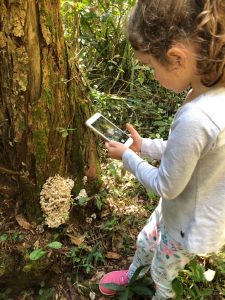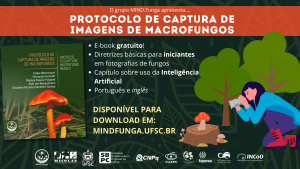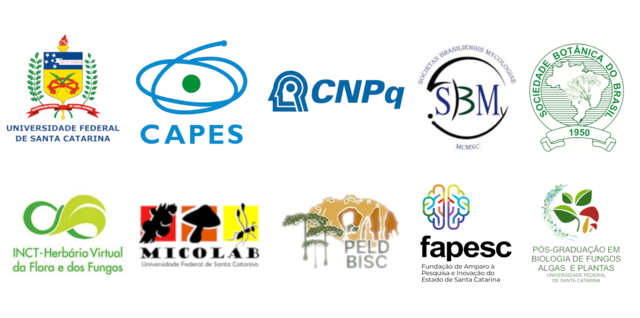(Português do Brasil) Venha conhecer a Galeria Funga do Brasil: O mais novo lançamento do MIND.Funga em 2024!
Lycoperdon sulcatostomum

Lycoperdon sulcatostomum. Photo: L. Treiveiler-Pereira.
Lycoperdon sulcatostomum is a gasteroid saprotrophic fungal species that is found growing on dead plant debris. The species is endemic from the southern Brazilian Atlantic Forest, occurring in Paraná (six occurrences) and Santa Catarina (three occurrences) states. Gasteroid fungal species diversity is well explored and documented in southern. southeastern and northeastern Brazil, making L. sulcatostomum to be considered rare, as the species produces conspicuous basidiomata and has few occurrences. Despite this, it is believed that the species can also occur in Argentina and Paraguay, as these countries have areas similar to the species known habitat. The Brazilian Atlantic Forest historically suffers anthropogenic disturbances, such as cattle grazing, urban expansion and land use change. As a result, only 28% of the biome original area remains. Based on the species rarity, its small population size, and the important habitat area and quality loss that L. sulcatostomum is subjected, it is considered Vulnerable under IUCN criteria (C2a(ii)).

L. sulcatostomum distribution map. https://www.iucnredlist.org/species/245800524/245801663.
References
Trierveiler-Pereira, L., Baltazar, J.M., Alves, C., Alves-Silva, G. & Costa-Rezende, D.H. 2023. Lycoperdon sulcatostomum. The IUCN Red List of Threatened Species 2023: e.T245800524A245801663. https://dx.doi.org/10.2305/IUCN.UK.2023-1.RLTS.T245800524A245801663.en. Accessed on 22 December 2023.
Bondarzewia loguerciae


Bondarwezia loguerciae. Photo: MIND.Funga.
Bondarzewia loguerciae is a wood inhabiting fungal species exclusively associated with Drimys angustifolia live and dead standing individuals. The species is considered endemic to cloud forests areas within southeastern Brazil, above 1000 m.a.s.l. In addition, B. loguerciae is considered rare, as it produces conspicuous basidiomata and, despite long time sampling efforts (since 2011) in the species known occurrence area, there are only then collections. These as distributed along Santa Catarina and Rio Grande do Sul states, within São Joaquim National Park and São Francisco de Paula National Park, respectively. Based on the species host distribution and requirements, it is expected that B. loguerciae occurs also in São Paulo and Minas Gerais states. The species population and habitat are threatened mainly by climate change and anthropogenic disturbances, such as cattle grazing, invasive species introduction, fire and land use change. As cloud forests are fragile due to its dependence on specific microclimate conditions and natural fragmentation, in conjunction with threats to the species and its habitat, it is suspected that B. loguerciae will suffer a 60-80% population reduction in the next 50 years, being assessed as Critically Endangered under IUCN criteria (A3c).

B. loguerciae distribution map. https://www.iucnredlist.org/species/245801951/245801953.
References
Kossmann, T., Alves-Silva, G., Bittencourt, F., Salvador Montoya, C.A., Funez, L., Werner, D. & Rajchenberg, M. 2023. Bondarzewia sp. nov. ‘loguerciae’. The IUCN Red List of Threatened Species 2023: e.T245801951A245801953. https://dx.doi.org/10.2305/IUCN.UK.2023-1.RLTS.T245801951A245801953.en. Accessed on 22 December 2023.
MIND.Funga closed voting for naming new species of fungi for science
The new species has been named Ophiocordyceps zombifica!
As a follow up from the Project “SBPC Vai à Escola”, conducted in the schools around the National Park of São Joaquim, MIND.Funga invites all society to vote for naming a new species of fungi. The species under consideration belongs to the genus Ophiocordyceps, which is represented by fungi species that parasite insects! The voting is one of the results from the project supported by SBPC, CNPq, FAPESC and INCT Herbário Virtual da Flora e dos Fungos, in which a paradidactic children’s book was produced and distributed to the schools around the National Park of São Joaquim, place where the new species was found. In the course of the project the students from the region had the opportunity to suggest names for the species, which can be seen in the form. The voting ends up during the “Week of science of Serra Catarinense”, taking place in Orleans and Urubici, coinciding with “19ª National Week of Science and Technology”. The voting ended up during the “Week of science of Serra Catarinense”, which took place in Orleans and Urubici, coinciding with “19ª National Week of Science and Technology”, during October 23rd to 28rd, 2022. The results of the voting were announced in MIND.Funga’s Instagram profile, with more information about the species and the voting!
Didactic material about Fungi
This didactic material entitled “Material Complementar ao livro Sistemática Vegetal I: Fungos”, aims to provide content about fungi, in the area of mycology, in a up-to-date way. Beyond the vast material on Fungi kingdom, there is also information about pseudofungi (Myxomycetes and Oomycetes). It is available for free and in Portuguese, you can access it by clicking [here].
MIND.Funga launches free e-book “Macrofungus Image Capture Protocol”
 Photographs are an important step for identification and taxonomy of macrofungi, through them the macroscopics structures that compose fungi can be observed, obtaining that way rich information about fungi morphology. Thinking about the need to obtain good photos to know and document the Funga, the e-book “Protocol for Capturing Macrofungi Images” was idealized. This guide is part of a larger project, which involves the development of an application for recognizing macrofungal species through photographs, and, in this important way, aims to provide tips for those who want to photograph macrofungi. We all know it is important that the images are informative and might help in the recognition of the diversity of these organisms. The basic guidelines range from the scenario preparation, going through all the angles of the fungus that must be photographed, important information to be registered, even about how the application is being developed to help in the recognition of species with the use of artificial intelligence.
Photographs are an important step for identification and taxonomy of macrofungi, through them the macroscopics structures that compose fungi can be observed, obtaining that way rich information about fungi morphology. Thinking about the need to obtain good photos to know and document the Funga, the e-book “Protocol for Capturing Macrofungi Images” was idealized. This guide is part of a larger project, which involves the development of an application for recognizing macrofungal species through photographs, and, in this important way, aims to provide tips for those who want to photograph macrofungi. We all know it is important that the images are informative and might help in the recognition of the diversity of these organisms. The basic guidelines range from the scenario preparation, going through all the angles of the fungus that must be photographed, important information to be registered, even about how the application is being developed to help in the recognition of species with the use of artificial intelligence.
The guide was developed in a multidisciplinary way by the MIND.Funga team developed together with the Laboratory of Image Processing and Computer Graphics from UFSC (LAPIX).
The bilingual (Portuguese and English) e-book “Macrofungus Image Capture Protocol” is now available for FREE download through the link. The species recognition app, MIND.Funga App, is still in the testing phase and the logo will be officially launched.
The realization of this book was only possible through partnerships and financial support from some entities, such as CNPQ, CAPES, FAPESC, PPGFAP/UFSC, INCT Herbário Virtual, SBPC and INCoD.
[Click here to download the E-Book]

Researchers identify endangered fungi and warn of the need for conservation policies
A fungus that transforms insects into zombies in the Itajaí Valley and a lichen that is only found between the dunes of a beach in Imbituba are some, of the at least, 21 new species of Brazilian fungi and lichens that will be included in the Red List of Threatened Species from the International Union Conservation of Nature (IUCN), one of the world’s leading inventories for the conservation status of animals, fungi and plants. The action is the result of a workshop organized by the MIND.Funga research group, linked to the Mycology Laboratory (Micolab) of Federal University of Santa Catarina (UFSC), in partnership with the IUCN Commission for the Survival of Fungal Species. The meetings held throughout September and October brought together, in addition to the MIND.Funga and Micolab teams, 18 researchers from nine states of five regions in the country. Until the end of the year, the group follow the process of the evaluation of another 30 proposals for including species on the Red List.
The first Brazilian workshop on the evaluation of fungal species for the IUCN Global Red List, in addition to training Brazilian human resources to classify the species in the categories of threat and the application of the IUCN criteria, aimed to engage researchers in the theme of conservation. The initial meetings aimed at the qualification of participants for elaborating the documentation needed. Subsequently, the proposals elaborated by the group were evaluated by two IUCN accredited evaluators: Chicago Botanical Garden Chief Scientist Gregory M. Mueller and Eastern Washington University professor Jessica Allen.

Rickiella edulis is a saprotrophic species (absorbs nutrients from decaying organic matter) that occurs in the Atlantic Forest, Argentina and Paraguay. It is considered endangered by IUCN criteria. Photo: Gerardo Robledo
The 21 species evaluated are distributed in two phyla (Ascomycota and Basidiomycota) and eight orders, and the majority is endangered to some degree. There are four Critically endangered (Extremely high risk of extinction in the wild); three in Endangered (Very high risk of extinction in the wild); nine Vulnerable (High risk of extinction in the wild); four Near threatened (low risk category, but with species close to be classified or likely to be included in one of the threatened categories in the near future); and one in the “Data Deficient” category (adequate data on its distribution and /or abundance is lacking to make a direct or indirect assessment of its risk of extinction).
The latter case is of Ophiocordyceps ainictos, a fungus that attacks and parasitizes larvae, probably of butterflies or moths, and controls their behavior, transforming them into true zombies. It is believed to be endemic to the region of Vale do Itajaí . “It is an extremely rare species that has only been found twice in 120 years, being so rare and mysterious that it was not even possible to determine its degree of threat, remaining in the ‘Data Deficient’ category, which indicates that it should be a focus of studies so that its biology and distribution can be better understood, thus complementing a better understanding of how threatened she is, inform professor Elisandro Ricardo Drechsler dos Santos and postdoctoral Diogo Henrique Costa Rezende, both researchers from MIND.Funga and coordinators of the workshop.

Ophiocordyceps ainictoshas only been seen twice in 120 years. Photo: Felipe Bittencourt

Species attacks and parasitizes larvae and controls their behavior. Illustration by A. Möller (1901)
Another endemic specie of Santa Catarina is Cladonia dunensis, lichen found only in a strip between the dunes of Praia de Itapirubá, in Imbituba. Due to this extremely restricted distribution, and precisely in an area highly targeted by tourism and real estate speculation, it was assessed as critically threatened with extinction. That is, if nothing is done, there is a high chance of disappearing in the coming decades.
Four of the species already evaluated will appear in the next IUCN online release, which will be divulged in December; the others will be published during the next year. On workshop website, it is possible to check all of them, as well as those that are still being analyzed. Other species that occur in Brazilian territory and have been already published on the global red list can be accessed on the MIND.Funga website.

Lichen Cladonia dunensis is found only in a strip between the dunes of Praia de Itapirubá, in Imbituba. Photo: Emerson Gumboski
Conservation of fungi and lichens

Fomitiporia nubicola is a wood-degrading species that, until now, has only been found in the Itajaí Valley and in the São Joaquim National Park, but it may also be found in the Southeast region of Brazil. Endangered, it is considered vulnerable by IUCN criteria. Photo: G. Alves-Silva
The results of the workshop call attention to the need to implement, in the country, policies for the conservation of funga – a term that designates species of fungi in a given region, in the same way that flora and fauna refer to plants and animals. “We all left the workshop with the understanding that something bigger needs to be done so that fungi are actually considered in the national scenario of biodiversity conservation”, comment the coordinators.
Fungi are essential for life on our planet. Even if we don’t always notice, they are an important part of our daily lives. The production of medicines and food (in addition to mushrooms, they are also present in the manufacture of cheeses, breads, wines and beers, among others) are just a few examples. Fungi are involved in key processes in natural ecosystems and allow that life as we know exists.
“However, more than 90% of fungal species are unknown to science, and we know that many of them might be endangered. Therefore, we are running an imminent risk of losing species of great ecological and economic importance without even knowing them. This scenario can be mitigated with the investment of resources for the recognition of this unknown biodiversity, as well as of those species that are threatened to be extinct, accompanied by policies that consider the fungi in studies of environmental impact, plans of national action and as indicators priorities of areas for conservation”, point out Drechsler-Santos and Costa-Rezende.

Aegis luteocontexta is another wood-degrading species considered rare and vulnerable. It occurs in the Atlantic Forest and potentially in the Amazon, in addition to Guyana and Costa Rica. Photo:: Felipe Bittencourt
Despite this, there is none type of policy for conservation of fungi in Brazil – they are not even mentioned in conservation laws or plans. There is also no red list for funga in the country – there are official lists only for flora and fauna. “It is urgent not only the need to train mycologists to assess the conservation status of species, but also to disseminate among academics and population that fungi are under threat, and that there is no public policy to defend them, as this is the only way for fungi to gain visibility on the national conservation agenda”, emphasize the workshop coordinators.
Assessing species and recognizing them as threatened with extinction is just the first step that must be taken. A major achievement, the researchers point out, would be the recognition, by the Ministry of the Environment, of these fungal species that have already been evaluated and published by the IUCN. “There are many needs for fungi to be truly recognized in a national conservation agenda, for this fungi need to be recognized in a public policy that involves all the society, institutions and the government itself, through the Ministry of the Environment, to fungi be incorporated into the legal aspects of Brazilian conservation”, reinforce Drechsler-Santos and Costa-Rezende.

Wrightoporia araucariae, so far, has only been seen growing on dead araucaria trunks – and only five times in the southern region of the country. Potentially follows the geographic distribution of the tree. It is critically endangered. Photo: M.A. Reck
MIND.Funga
In addition to studies about fungal communities, MIND.Funga is dedicated to extension and scientific education actions, such as the production of a children’s book. Also noteworthy are the Citizen Science projects , in which the residents of the surroundings of the Conservation Units join efforts with researchers to increase the recognition of native species. The group is supported by the Support for Scientific and Technological Research Foundation of Santa Catarina State (Fapesc), National Council for Scientific and Technological Development (CNPq) and Coordination for the Improvement of Higher Education Personnel (Capes).
Camila Raposo/Jornalista da Agecom/UFSC
Translation by Edilene de Souza Leite
(Português do Brasil) Aprender para conservar – as descobertas sobre o Reino Fungi!
Trametopsis brasiliensis opens the list of assessed species

1st Brazilian Workshop on Fungal Species Assessment for the IUCN Global Red List
The MIND.Funga team in partnership with members of the IUCN Commission for the Survival of Fungal Species is promoting the 1st Brazilian Fungal Species Assessment Workshop for the IUCN Global Red List. In this week (Nov 18-22), the event will be in the third meeting:
- 1st meeting: the group will discuss the application of the IUCN criteria for assessing the conservation status of species through theoretical and practical activities;
- 2nd meeting: Workshop guests will bring assessment information of 2 or 3 species already in the proposal format to be on the IUCN red list. The proposals will be discussed and improved with the support of the professors;
- 3rd meeting: each participant will present new assessment information together with the species already discussed in the second meeting and the proposals will be evaluated by certified IUCN evaluators (Gregory M. Mueller and Jessica Allen).
We invited 17 mycologists and lichenologists (mostly Brazilians) to participate in this important initiative for the conservation biology and recognition of Funga.
The main idea of the event is to engage Brazilian mycology/lichenology specialists in the extremely important topic of conservation. In this way, we hope that those involved are trained throughout the process and continue to propose species for the global list. We need, as Brazilian mycology, to generate a wave of collaborations and that is why we have as supporting partners, the Species Survival Commission International Union for Conservation of Nature (SSC IUCN), MIND.Funga/MICOLAB/UFSC, the Brazilian Society of Mycology (SBMic), the Center for Specialists in Mycology of the Botanical Society of Brazil (NEMic from SBB), and the INCT Virtual Herbarium of Flora and Funga.

- Página 1 de 2
- 1
- 2









